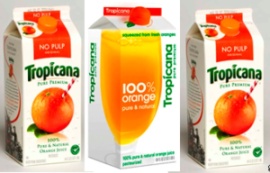In today’s New York Times, Stuart Elliott provides the back story on Tropicana’s ill-received packaging redesign. This issue first came to my attention back around the New Year when my wife spotted it in our local grocery store and succinctly opined “Yuck.” I knew right then they were in trouble…

Anyway, this story once again highlights the unprecedented power that access affords today’s consumers. Through blogs and emails, Tropicana fans demanded the return of their familiar package and it’s easily-recognized-on-a-crowded-shelf Straw In Orange brand symbol. They also didn’t shy from critiquing the ‘generic store brand’ feel of the rather flat new graphics.
In the spirit of full-disclosure, let me admit that I worked on this brand through a string of division President’s and CMO’s from 2001-2008, and that further, I’m not much of a fan of Pepsi’s recent and pricey product redesigns—with the notable exception of a much-improved Sierra Mist. However, I kept my opinions to myself while a groundswell of others apparently didn’t. And so, mere months into this very expensive process, Tropicana recognized the wisdom of embracing this public feedback. And good for them.
Interestingly, their President, a UK transplant named Neil Campbell, cites the negative response from their most loyal consumers as key to the reversal, admitting “What we didn’t get was the passion this very loyal small group of consumers have. That wasn’t something that came out in the research.”
Of course it didn’t come out in the research. Any practicing creative could tell you that. Those of us who make a living dreaming up ideas quickly grow skeptical of the dodgy pseudoscience behind market testing and the mystifying faith too many clients put into their measurements of consumer opinions. Somehow, this entire industry built its metrics around what people say, often in public among a group of peers.
I hate to be the bearer of bad news but people lie. We all lie. We lie all the time, for reasons good and bad, but the inescapable fact remains you can not put all of your faith in the veracity of peoples’ words and what they claim in a focus group.
Happily, the web’s mighty data engine now allows us to measure what people actually do and how they act in the real world, as opposed to the often groupthink statements they make while being interviewed in the windowless confines of focus group rooms.
So while many will recognize this Tropicana incident as yet another cautionary tale about the ever-expanding role consumer influence has on brand marketing, we can also take away another critical lesson: we need to update our testing methods to take advantage of our easy-access to the real world, behavior-based data all around us.
You want to determine the relative merits of two marketing approaches? Don’t make some mock-ups and hold a focus group–create rich media banners of both of them and run online test markets and see which one performs better out in the real world. This type of production costs very little—and unlike animatics, the creative materials actually drive sales as they’re being tested. Imagine that: faster, cheaper, and more accurate testing awaits all of us online…
Why exactly is anyone still debating this?
Here-here, hallelujah and all that jazz.
If I’ve learned anything in my short time in this business, it’s that research, in its current incarnation, is at best unreliable and at worst downright misleading. Right Tropicana?
And who knows, there may be something to this “internet” you speak of… I’m not sold, but it may just catch on.